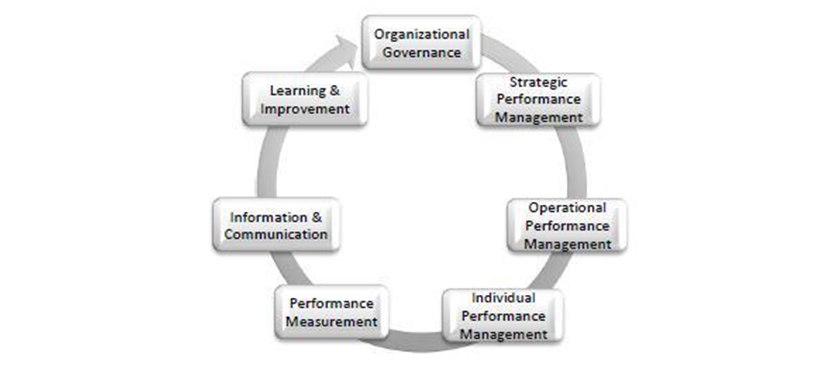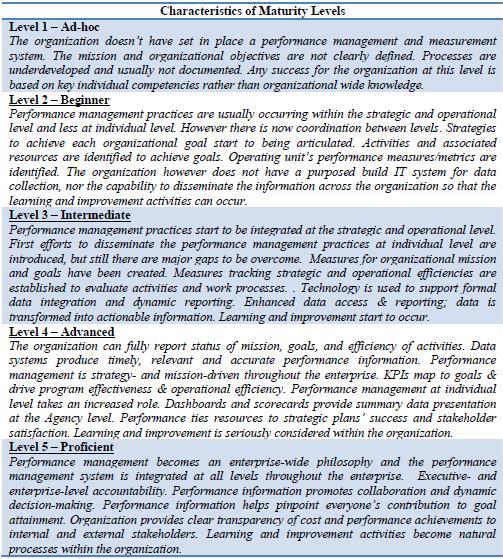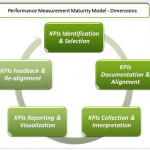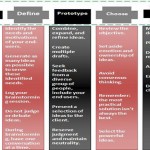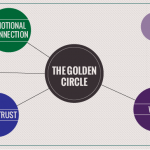Assessing organizational performance management capability – The Performance Management Maturity Model
A model is a simplified representation of the world. According with The American Heritage Dictionary (2001), a model can have multiple significations, one of the most used being “a schematic description of a system, theory, or phenomenon, that accounts for its known or inferred properties and may be used for further study of its characteristics”.
In line with this definition, a maturity model is a process that describes the development of an entity over time and has the following characteristics:
• The development process is described by using a limited number of levels
• Each level is characterized by specific requirements, which must be achieved in order to pass to the next level
• Levels are sequentially ordered, from an initial level up to an ending level, and
• The development process requires a progress from one level to the next one, no levels being allowed to be left out (Klimko, 2001)
One of the most popular examples of a maturity model is the Maslow Pyramid. Maslow (1943) suggested that there is a hierarchy of human needs starting from physiological needs up to the self actualization needs, and that during the progress through the hierarchy, ideally all the levels must be achieved by individuals. However, similar adapted patterns can be applied in order to assess the development stages of almost every entity, no matter of its nature or form. Such an entity could be today’s modern organization.
Over the last decades, management models designed to assess performance and identify different opportunities for improvement have began to be identified by the organizations as important strategic tools for building capabilities and achieve competitive advantages. In line with these developments, the specialists from the Office of Government Commerce (OGC), UK (2008) consider that maturity models, in particular, have become essential tools in assessing organizations’ current capabilities which help in their processes to implement change and improvements in a structured way. According to OGC, there are a number of reasons why organization might choose to use a maturity model in order to assess their current capabilities, such as:
The model proposed below is a Maturity Model for Performance Management and is the result of an academic research project using three data sources:
- review of specialized literature in performance management and measurement,
- review of highly acknowledged maturity models, and
- insights from performance management practitioners.
The above proposed model is built on seven dimensions each describing an important characteristic of a Performance Management System.
The Performance Management Maturity Model uses a five level maturity framework which is adapted from The Capability Maturity Model Integration (CMMI, 2001) and Portfolio, Programme and Project Management Maturity Model (P3M3 Models, 2008). Thus, organizations can assess the maturity level of their performance management practices in each of the seven dimensions of the model against the 5 maturity levels identified and described below.
The model presented above represents a new tool that organizations can employ for assessing the maturity of their performance management capability. For more details about how such a model can generate value in an organizational context, contact eab group.
References:
- Adrian Brudan (2009) – “Performance Management Maturity Level in Business Organizations”, Master thesis, Aarhus School of Business, Denmark
- Klimko, G. (2001) – Working paper. Knowledge management and maturity models. Building common understanding. Second European Conference of Knowledge Management, pp 269-278
- Maslow, A (1943) – A theory of human motivation. Psychological Review, Vol. 50, pp 370-396
- P3M3 – Portfolio, Programme and Project Management Maturity Model (2008) – Pubic Consultation Draft, Office of Government Commerce
- SEI -Capability Maturity Model Integration -CMMI- (2001) – Carnegie Mellon University, Software Engineering Institute
- The American Heritage Dictionary (2001), 4th Edition, American Heritage Publishing Company
- Adapted from P3M3 (2008), draft paper
- Adrian Brudan, 2009

Tags: Adrian Brudan, EAB group, Management performance, Maturity Model, Theory
